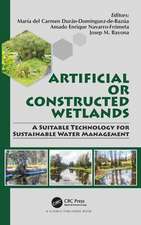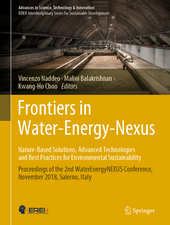Combined Application of Physico-Chemical & Microbiological Processes for Industrial Effluent Treatment Plant
Editat de Maulin Shah, Aditi Banerjeeen Limba Engleză Paperback – 26 aug 2021
Collectively referred to as the "emerging contaminants," they are mostly derived from domestic use and occur in trace concentrations ranging from pico to micrograms per liter. Environmental contaminants are resistant to conventional wastewater treatment processes and most of them remain unaffected, leading to the contamination of the receiving water. As such, there is a need for advanced wastewater treatment process that is capable of removing environmental contaminants to ensure safe fresh water supplies. This book explains the biological and chemical wastewater treatment technologies. The biological wastewater treatment processes presented include: (1) bioremediation of wastewater such as aerobic and anaerobic treatment; (2) phytoremediation of wastewater using engineered wetlands, rhizofiltration, rhizodegradation, phytodegradation, phytoaccumulation, phytotransformation and hyperaccumulators; and (3) mycoremediation of wastewater. The chemical wastewater treatment processes discussed include chemical precipitation, ion exchange, neutralization, adsorption and disinfection.
In addition, the book describes wastewater treatment plants in terms of plant size, layout and design as well as installation location. Also presenting the latest, innovative effluent water treatment processes, it is a valuable resource for biochemical and wastewater treatment engineers, environmental scientists and environmental microbiologists.
| Toate formatele și edițiile | Preț | Express |
|---|---|---|
| Paperback (1) | 646.43 lei 6-8 săpt. | |
| Springer Nature Singapore – 26 aug 2021 | 646.43 lei 6-8 săpt. | |
| Hardback (1) | 652.81 lei 6-8 săpt. | |
| Springer Nature Singapore – 31 mar 2020 | 652.81 lei 6-8 săpt. |
Preț: 646.43 lei
Preț vechi: 760.50 lei
-15% Nou
Puncte Express: 970
Preț estimativ în valută:
123.71€ • 128.68$ • 102.13£
123.71€ • 128.68$ • 102.13£
Carte tipărită la comandă
Livrare economică 12-26 aprilie
Preluare comenzi: 021 569.72.76
Specificații
ISBN-13: 9789811504990
ISBN-10: 9811504997
Ilustrații: IX, 407 p. 68 illus., 45 illus. in color.
Dimensiuni: 155 x 235 mm
Greutate: 0.59 kg
Ediția:1st ed. 2020
Editura: Springer Nature Singapore
Colecția Springer
Locul publicării:Singapore, Singapore
ISBN-10: 9811504997
Ilustrații: IX, 407 p. 68 illus., 45 illus. in color.
Dimensiuni: 155 x 235 mm
Greutate: 0.59 kg
Ediția:1st ed. 2020
Editura: Springer Nature Singapore
Colecția Springer
Locul publicării:Singapore, Singapore
Cuprins
Chapter 1. By-products from Forest Activities as Low-cost Sorbents for Bio-remediation of Effluents and Other Polluted Media.- Chapter 2. Exopolysaccharides: Production and its Application in Industrial Waste Water Treatment.- Chapter 3. Treatment Technologies for Addressing the Removal of Industrial Effluents Affecting the Quality of River Ganges in Eastern part of Uttar Pradesh, India.- Chapter 4. Microbial Treatment for Removing Synthetic Dyes from Industrial Effluents.- Chapter 5. Role of Interspecies Electron Transfer for Boosting Methane Production by Anaerobic Digestion in Syntrophic Methanogenesis.- Chapter 6. Recent Advances in Physico-chemical and Biological Treatment Approached for Distillery Wastewater.- Chapter 7. Integrated Approach for the Treatment of Industrial Effluent by Physio-Chemical and Microbiological Process for Sustainable Environment.- Chapter 8. Treatment Options for Acid Mine Drainage: Remedial Achievements through Microbial Mediated Processes.- Chapter 9. Elaboration and Characterization of Porous Materials from Moroccan Natural Resources: Application to Industrial Wastewater Treatment.- Chapter 10. Organic Contaminants in Industrial Wastewater: Prospects of Waste Management by Integrated Approaches.- Chapter 11. Realistic Approach for Bioremediation of Heterogeneous Recalcitrant Compounds.- Chapter 12. Bioremediation of Lignin Rich Pulp and Paper Industry Effluent.- Chapter 13. Bioremediation of Chromium using a Laboratory Scale Sand Bed Reactor.- Chapter 14. Electrobioremediation of Contaminants: Concepts, Mechanisms, Applications, and Challenges.- Chapter 15. Electrochemical Methods for the Detection of toxic As(III) and As(V) from Natural Water.- Chapter 16. Bio Nano Approaches: Green and Sustainable Treatment Technology for Textile Effluent Challenges.- Chapter 17. Removal of Dyes from Industrial Effluents by Application of Combined Biological and Physio-Chemical Treatment Approaches.
Notă biografică
Dr. Maulin P. Shah is Chief Scientist & Head of the Industrial Waste Water Research Lab, Division of Applied and Environmental Microbiology Lab at Enviro Technology Ltd., Ankleshwar, Gujarat, India. His work focuses on the impact of industrial pollution on the microbial diversity of wastewater, and genetically engineering high-impact microbes for the degradation of hazardous materials. He is an active editorial board member in top-rated journals.
Dr. Aditi Banerjee currently holds an Independent Research Scientist position in the Centre for Nanotechnology, IIT Guwahati, supported by the Department of Science and Technology, Government of India. She started her research career as an environmentalist, focusing on treating petrochemical and refinery generated wastewater by biological methods. She has long expertise in designing and solving environmental-related issues concerning soil, water, and air. Her wide experience transcends into interdisciplinary approaches and application of treating and making wealth from waste. She has published more than 15 international research publications and 2 books.
Textul de pe ultima copertă
In recent decades, scientific insight into the chemistry of water has increased enormously, leading to the development of advanced wastewater and water purification technologies. However, the quality of freshwater resources has continually deteriorated worldwide, both in industrialized and developing countries. Although traditional wastewater technologies focus on the removal of suspended solids, nutrients and bacteria, hundreds of organic pollutants occur in wastewater and urban surface waters. These new pollutants are synthetic or naturally occurring chemicals that are not often monitored in the environment but have the potential to enter the environment and cause known or suspected adverse ecological and / or human health effects.
Collectively referred to as the "emerging contaminants," they are mostly derived from domestic use and occur in trace concentrations ranging from pico to micrograms per liter. Environmental contaminants are resistant to conventional wastewater treatment processes and most of them remain unaffected, leading to the contamination of the receiving water. As such, there is a need for advanced wastewater treatment process that is capable of removing environmental contaminants to ensure safe fresh water supplies. This book explains the biological and chemical wastewater treatment technologies. The biological wastewater treatment processes presented include: (1) bioremediation of wastewater such as
aerobic and anaerobic treatment; (2) phytoremediation of wastewater using engineered wetlands, rhizofiltration, rhizodegradation, phytodegradation, phytoaccumulation, phytotransformation and hyperaccumulators; and (3) mycoremediation of wastewater. The chemical wastewater treatment processes discussed include chemical precipitation, ion exchange, neutralization, adsorption and disinfection.In addition, the book describes wastewater treatment plants in terms of plant size, layout and design as well as installation location. Also presenting the latest, innovative effluent water treatment processes, it is a valuable resource for biochemical and wastewater treatment engineers, environmental scientists and environmental microbiologists.
Collectively referred to as the "emerging contaminants," they are mostly derived from domestic use and occur in trace concentrations ranging from pico to micrograms per liter. Environmental contaminants are resistant to conventional wastewater treatment processes and most of them remain unaffected, leading to the contamination of the receiving water. As such, there is a need for advanced wastewater treatment process that is capable of removing environmental contaminants to ensure safe fresh water supplies. This book explains the biological and chemical wastewater treatment technologies. The biological wastewater treatment processes presented include: (1) bioremediation of wastewater such as
aerobic and anaerobic treatment; (2) phytoremediation of wastewater using engineered wetlands, rhizofiltration, rhizodegradation, phytodegradation, phytoaccumulation, phytotransformation and hyperaccumulators; and (3) mycoremediation of wastewater. The chemical wastewater treatment processes discussed include chemical precipitation, ion exchange, neutralization, adsorption and disinfection.In addition, the book describes wastewater treatment plants in terms of plant size, layout and design as well as installation location. Also presenting the latest, innovative effluent water treatment processes, it is a valuable resource for biochemical and wastewater treatment engineers, environmental scientists and environmental microbiologists.
Caracteristici
Illustrates the importance of various physico-chemical processes along with biological & oxidation processes in effluent treatment plant Introduces new trends in environmental bioremediation of effluent water Explains the reuse of the treated wastewater through emerging advance oxidation technologies for effluent treatment plant Emphasizes the role of nanotechnology in bioremediation of pollutants in water Highlights the occurrence of novel micro-pollutants













